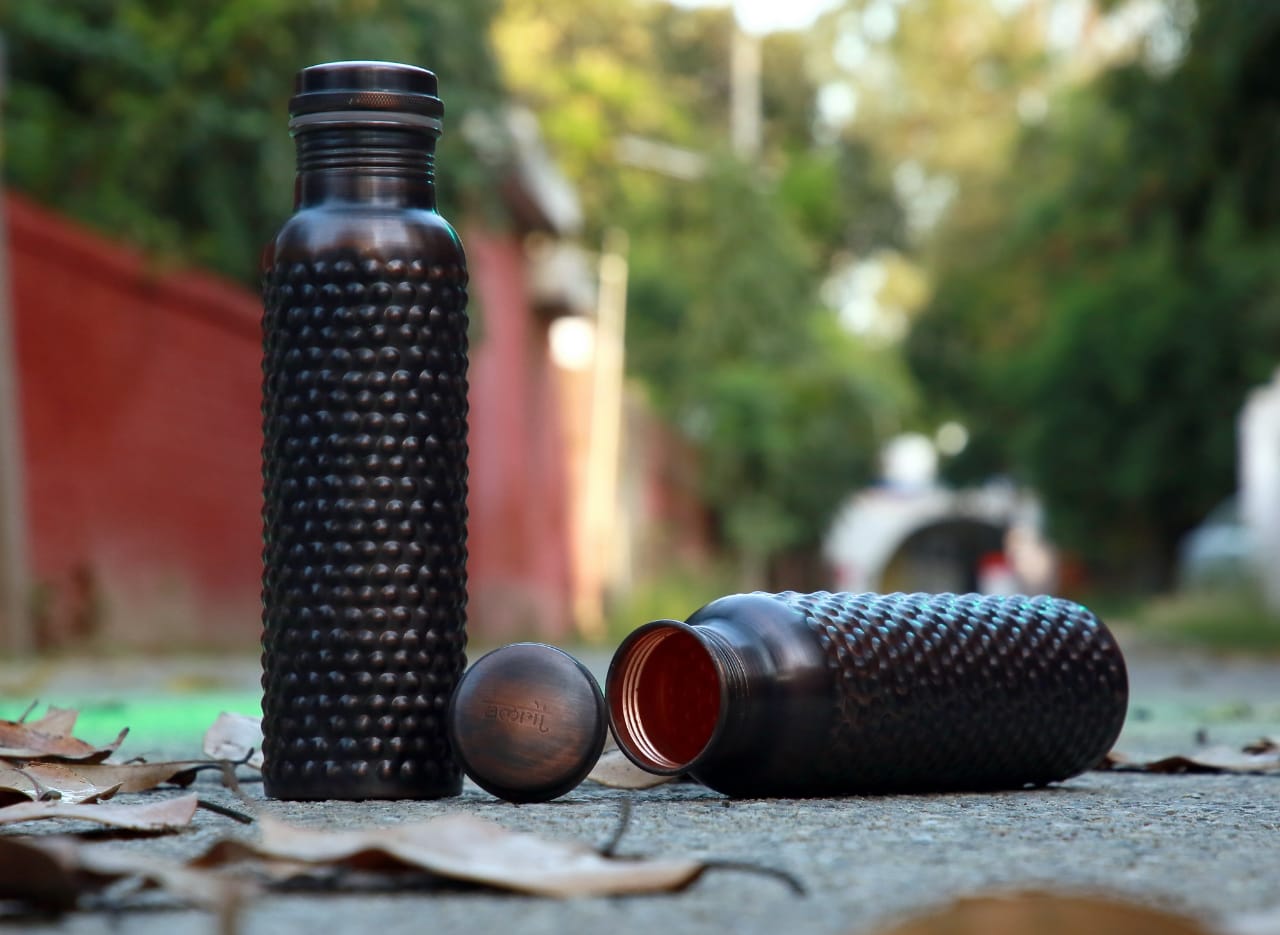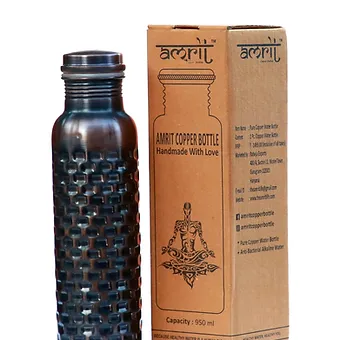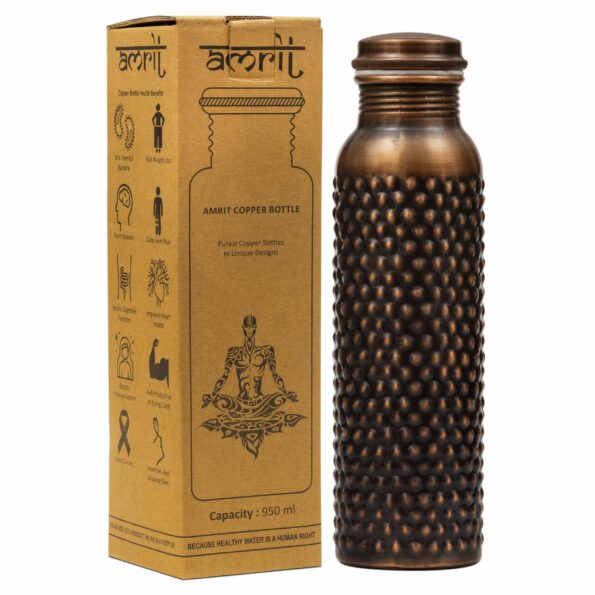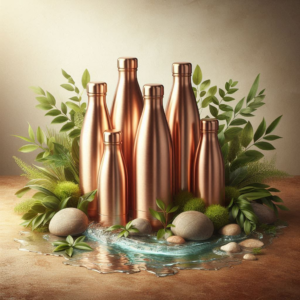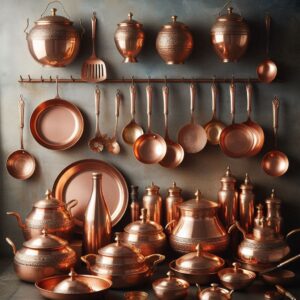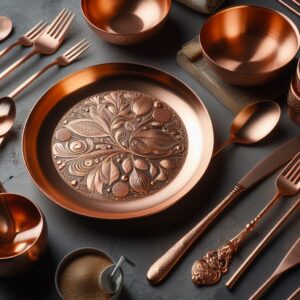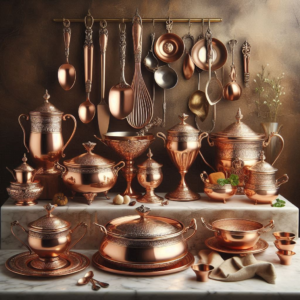Are Copper Water Bottles Safe? Did you know that drinking water from a copper bottle can benefit your health in many ways? You might have seen some trendy copper water bottles on Instagram or Pinterest, but do you know the science behind them? In this blog, we’ll explore the ancient Ayurvedic practice of storing and drinking water from copper vessels, also known as “tamra jal”. We’ll also look at the benefits, risks, and tips of using copper water bottles in the modern world. So, grab a glass of water (preferably from a copper bottle) and let’s dive in!
For centuries, Are Copper Water Bottles Safe have been a staple in Ayurvedic practice, touted for their health benefits. Today, they’ve seen a resurgence in popularity, gracing the hands of celebrities and health enthusiasts alike. But is the trend all it’s cracked up to be? This article delves into the science and tradition behind copper water bottles, exploring both the potential benefits and the hidden dangers associated with this ancient practice. We’ll separate fact from fiction, helping you decide if a copper water bottle is the right choice for you.
Benefits of Copper Water Bottles
Copper is a trace mineral that is essential for various bodily functions, such as producing red blood cells, maintaining nerve health, and supporting the immune system. However, most of us don’t get enough copper from our diet, which can lead to deficiency and health problems. That’s where copper water bottles come in handy.
According to Ayurveda, the ancient Indian system of medicine, copper water bottles can help balance the three doshas (vata, pitta, and kapha) in the body by gently infusing the water with the positive health properties of copper. This process is called “tamra jal”, which literally means “copper water” in Sanskrit.
Tamra jal is believed to have the following benefits:
- Boosting immunity: Copper water bottles can help fight off infections and diseases by killing harmful bacteria and viruses in the water and in the body. In fact, the U.S Environmental Protection Agency (EPA) has registered copper as the only solid material that kills bacteria and protects us from vulnerable health risks.
- Enhancing digestion: Copper bottles can help improve digestion and metabolism by stimulating the enzymes and bile production in the stomach and liver. They can also help prevent or relieve common digestive issues, such as acidity, gas, bloating, and constipation.
- Preventing infections: Copper water bottles can help prevent or treat infections in the mouth, throat, and respiratory tract by acting as a natural antiseptic and anti-inflammatory agent. They can also help heal wounds and ulcers faster by promoting tissue regeneration and blood circulation.
- Improving skin health: Copper water bottles can help improve skin health and appearance by enhancing the production of collagen and elastin, the proteins that keep the skin firm and elastic. They can also help prevent or reduce acne, blemishes, pigmentation, and signs of aging by fighting free radicals and oxidative stress.
- And more: Copper water bottles can also help with other aspects of health, such as regulating blood pressure, reducing cholesterol, preventing anemia, enhancing brain function, and supporting thyroid health.
-
Amrit Antique Brick Copper Bottle| 950ml, 300 gms| No Outer Cleaning Required
Original price was: ₹1,499.00.₹1,199.20Current price is: ₹1,199.20. -
Amrit Antique Copper Bottle and Glasses | No Outer Cleaning Required
Original price was: ₹2,199.00.₹1,759.20Current price is: ₹1,759.20. -
Amrit Antique Pine Copper Bottle| 950ml, 300 gms
Original price was: ₹1,499.00.₹1,049.00Current price is: ₹1,049.00.
Sounds amazing, right? But don’t take our word for it. There are also some scientific studies that support the claims of copper water bottles, such as this one that found that copper water bottles can reduce the risk of waterborne diseases, or this one that found that copper water bottles can improve the quality of drinking water.
Risks of Copper Water Bottles
Are Copper Water Bottles Safe? Before you rush to buy a copper water bottle, you should also be aware of the potential risks and drawbacks of using them. Copper water bottles are not without risks and there are some precautions and limitations to consider before using them.
Here are some of the possible risks of copper water bottles:
- Copper toxicity: Copper water bottles can cause copper toxicity if the water is stored for too long or if the water is too acidic. Copper toxicity can lead to symptoms such as nausea, vomiting, headache, dizziness, abdominal pain, and liver damage. To avoid this, you should not store water in a copper water bottle for more than 8 hours and you should not store acidic liquids, such as lemon juice, vinegar, or soda, in a copper water bottle.
- Allergic reactions: Copper water bottles can cause allergic reactions in some people who are sensitive or allergic to copper. Allergic reactions can manifest as skin rashes, itching, swelling, or breathing difficulties. To avoid this, you should consult your doctor before using a copper water bottle if you have a history of copper allergy or intolerance.
- Acidic corrosion: Copper water bottles can corrode over time due to the exposure to air and water. This can result in the formation of a greenish layer on the surface of the bottle, called patina. Patina is not harmful and can be easily removed by cleaning the bottle with a natural acidic solution, such as lemon juice or vinegar. However, if the patina is not removed, it can affect the taste and quality of the water and reduce the benefits of the copper water bottle.
- Contamination: Copper water bottles can also get contaminated by dirt, dust, or bacteria if they are not cleaned and stored properly. This can negate the benefits of the copper water bottle and cause health problems. To avoid this, you should clean your copper water bottle regularly with a mild soap and water and dry it thoroughly before storing it. You should also keep your copper bottle away from direct sunlight, heat, or moisture.
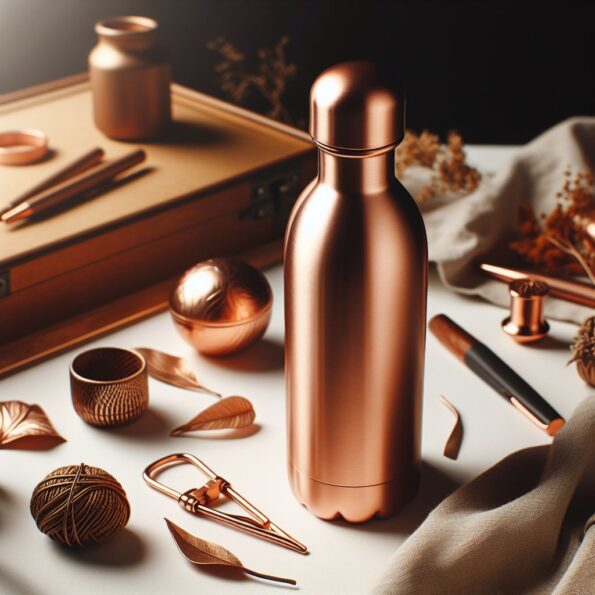
Tips on Using Copper Water Bottles Correctly and Safely
Are Copper Water Bottles Safe? Now that you know the benefits and risks of copper water bottles, you might be wondering how to use them correctly and safely. Don’t worry, we’ve got you covered.
Here are some best practices on how to use copper water bottles based on the Ayurvedic tradition and modern research:
Choose a high-quality copper water bottle:
Not all copper water bottles are created equal. Some may contain impurities, additives, or coatings that can affect the quality and safety of the water. To ensure that you get the best copper water bottle, you should look for one that is made of pure copper, has a smooth and shiny surface, and has a leak-proof cap. You should also avoid copper water bottles that are too cheap, too thin, or too heavy, as they may indicate low quality or fake copper.
Clean your copper water bottle before using it for the first time:
Before you use your copper water bottle for the first time, you should rinse it with a natural acidic solution, such as lemon juice or vinegar, to remove any dirt or residue. Then, you should fill it with room temperature water and let it sit for 6-8 hours. This will allow the water to absorb the copper ions and become tamra jal. You can also add some mint leaves, cucumber slices, or rose petals to the water to enhance the flavor and aroma.
Drink a glass of tamra jal first thing in the morning:
The best time to drink tamra jal is in the morning, on an empty stomach. This will help flush out the toxins, stimulate the digestive system, and boost the metabolism. To perform the tamra jal ritual, you should fill your copper water bottle at night, drink a glass of water first thing in the morning, and wait for 30 minutes before eating or drinking anything else. You can also drink another glass of tamra jal before going to bed, but make sure to refill the bottle for the next morning.
Drink in moderation:
While tamra jal has many benefits, you should not drink too much of it, as it can cause copper toxicity or imbalance. The recommended amount of tamra jal is about 2-3 glasses per day, or about 16-24 ounces. You should also drink plain water throughout the day to stay hydrated and balanced. If you experience any adverse effects, such as nausea, vomiting, or headache, you should stop drinking tamra jal and consult your doctor.
Keep your copper water bottle dry, clean, and safe:
To maintain the quality and safety of your copper water bottle, you should keep it dry, clean, and safe. You should clean your copper water bottle once a week with a mild soap and water and dry it thoroughly before storing it. Avoid storing acidic liquids, such as lemon juice, vinegar, or soda, in your copper water bottle, as they can corrode the copper and cause toxicity.
Keep your copper water bottle away from direct sunlight, heat, or moisture, as they can damage the copper and cause contamination. Finally, you should replace your copper water bottle if it shows signs of damage or wear, such as cracks, dents, or leaks.
Conclusion
Are Copper Water Bottles Safe more than just a fashion accessory. They are a powerful tool to improve your health and wellness, based on the ancient Ayurvedic practice of tamra jal. By using copper water bottles correctly and safely, you can enjoy the benefits of copper water bottles, such as boosting immunity, enhancing digestion, preventing infections, improving skin health, and more. You can also avoid the risks of copper water bottles, such as copper toxicity, allergic reactions, acidic corrosion, and contamination.
So, what are you waiting for? Try a copper water bottle for yourself and see the difference. You can find a high-quality copper water bottle at our online store, where we offer a variety of designs, sizes, and prices to suit your needs and preferences. You can also check out our blog for more tips and tricks on how to use copper water bottles and other Ayurvedic products. And don’t forget to share your experience and feedback with us. We’d love to hear from you!

